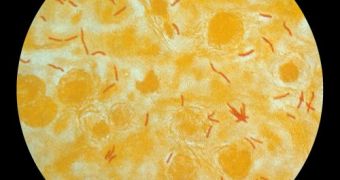Researchers at the Pasteur Institutes in Seoul and Paris and Institute of Pharmacology and Structural Biology (IPBS) in Toulouse found out the tuberculosis causing agent, M. tuberculosis manages to survive into body cells that were supposed to destroy it.
Tuberculosis, or TB, is an extremely contagious disease of the lungs and other organs that infects a third of the world's population, making one-in-ten to one-in-twenty infected individuals sick or infectious at one point in their life.
Mycobacterium tuberculosis should be destroyed by body structures called phagosomes, which are part of the body's immune system.
The problem is that mycobacteria somehow blocks phagosome maturation and not only survives but progresses inside host macrophages.
Finding out how the bacteria does this is establishing new therapeutic targets for TB treatment and also understanding how the intracellular parasitism works.
So scientists generated 11,000 different mutants of the M. tuberculosis Beijing strain, associated with large outbreaks of tuberculosis, multidrug resistance and increased virulence.
They used a high-throughput visual assay, to screen for mutant mycobacteria that was no longer able to stop phagosomal maturation.
It was an “enabling stringent selection of mutants that have the most pronounced subcellular localization within intracellular acidic compartments through the use of automated confocal quantitative imaging,” according to lead author Dr. Priscille Brodin, head of the Inserm Avenir Unit at Institut Pasteur Korea.
“Our approach may be useful to identify virulence genes in other intracellular pathogens,” she added.
Ten different mutants were identified, only one of which was previously known to play a part in phagosome maturation arrest.
The research found that the biosynthesis of particular glycolipids containing acyltrehalose was disturbed, suggesting that these glycolipids play a critical role in the early intracellular protection of mycobacteria.
“Our study unravels the role of novel lipid molecules in mycobacterial intracellular parasitism,” said Dr. Olivier Neyrolles leader of a CNRS Unit at IPBS in Toulouse France.
“This establishes potential new drug targets,” that could destroy the multidrug-resistant and extensively drug-resistant TB, e! Science News reports.
Dr Brodin notes that “the assay that we have developed can be readily adapted for the screening of novel antimicrobials.”

 14 DAY TRIAL //
14 DAY TRIAL //